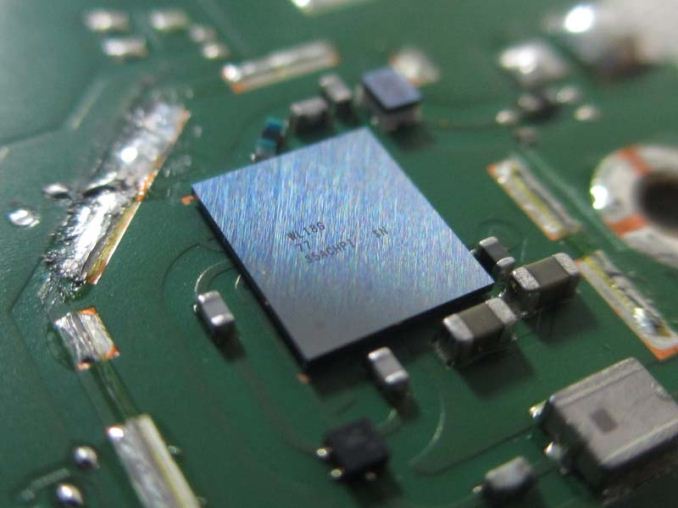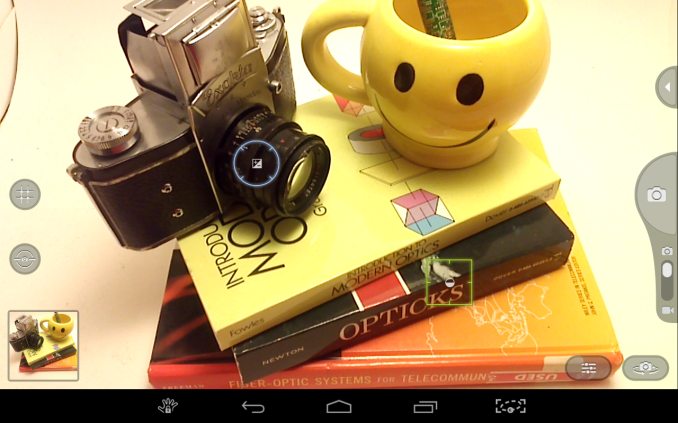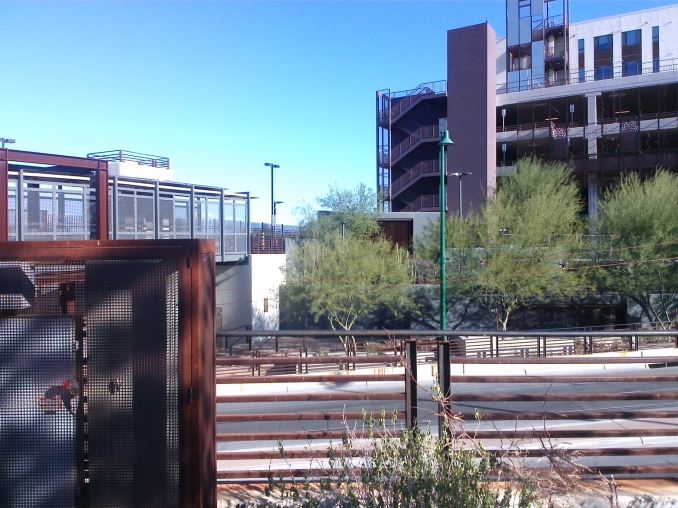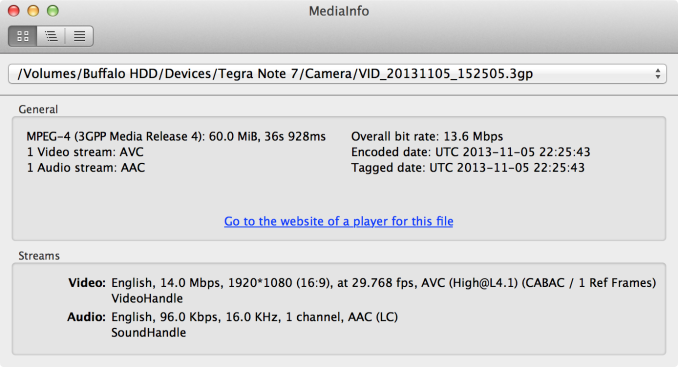NVIDIA Tegra Note 7 Review
by Brian Klug on November 12, 2013 9:01 AM EST- Posted in
- Tablets
- Mobile
- Tegra 4
- NVIDIA
- Tegra Note
WiFi, Camera, Speaker
WiFi
WiFi onboard Tegra Note is courtesy a TI Wilink 8 (WL18xx) series combo which also powers Bluetooth 4.0/LE. I keep hearing that TI has exited the mobile space completely, the reality is that TI continues to have a combo business and makes the PMICs for NVIDIA’s Tegra 4 SoC lineup. In addition the Tegra Note uses a TI GNSS (GPS and GLONASS).
Anyhow Tegra Note includes single stream 2.4 GHz WiFi, 802.11b/g/n, Miracast, and Bluetooth 4.0/LE. I’d love to see 5 GHz be a baseline, but that’s still not the case here, and also has the side effect of making the Tegra Tab incompatible with GameStream.

Throughput on iPerf in our test isn’t bad however among the 2.4 GHz only tests.
Camera
Cameras onboard Tegra Note are 5 MP on the rear, VGA on the front. The rear facing camera CMOS is an OV5690, which is a 1/4“ sensor with 1.4µm pixels, and the front facing camera CMOS is an OV7695 1/13” sensor with 1.75µm pixels. The rear facing camera is F/2.0 with a 4.0 mm focal length according to EXIF, although I’m not sure if I actually believe it, as the field of view looks a lot wider than I’d expect.
Regardless the Tegra Note is our first chance to see Tegra 4’s ISP and something else new, Camera Awesome for Android which is launching with Tegra Note 7. I’ve been complaining about the stock Android camera application for a while, which thankfully the Note 7 doesn’t include. Instead the default camera application is Camera Awesome, whose UI implements a number of the Chimera camera architecture features like tap to track, full resolution burst capture, and in a future release, always-on HDR.
Unfortunately the UI makes the same critical mistake that I see in the stock Android camera, and presents a 16:9 aspect crop of the 4:3 image formed on the sensor. The result is that images have more visible area above and below the preview area shown in the camera application.
Still image quality is actually a lot better than I expected it to be, but looks like a smartphone camera from a year or two ago. It’s adequate enough for a tablet but wouldn’t be competitive in the smartphone space, a few images are a bit hazy as well. I made sure to wipe the cover glass atop the camera between shots, but it’s possible this still contributed to the hazy appearance of a few of the sample shots. Tablets just need to have a camera these days, I’d argue that the one in Tegra Note gets the job done well enough.
Video on the rear facing camera is 1080p30, H.264 High profile with 1 reference frame, at 14 Mbps. I’ve uploaded the video to YouTube for quick viewing and to our servers if you want to see it without a transcode. Oddly enough the file format is .3gp, something I haven’t seen in quite a while. Video has an overexposed appearance and exposure distractingly hunts around quickly quite a lot even in the 40 seconds at the bench location, AF also runs quite a bit. I’m a bit disappointed in overall video quality and hope it improves dramatically with the December update. You can check off the box for video recording on Tegra Note, but not much beyond that.
Speaker
Since the HTC One, front facing speakers are starting to be a regular affair. The Nexus 7 (2013) shipped with stereo speakers, but they fire out the back. I measured the Tegra Note 7 using two songs that I’ve used for comparisons before and the sound data logger I’ve always used. I expected the Tegra Note to come out on top just because of the front facing speakers, oddly enough in terms of loudness the Nexus 7 was slightly ahead, although I suspect the A weighting I’ve always used might give it an edge.
| Speaker Loudness Comparison | ||||
| ASUS Nexus 7 (2013) | EVGA Tegra Note 7 | |||
|
Don't Move (dBA) |
82.11 | 81.92 | ||
|
Feel It All Around (dBA) |
83.44 | 82.90 | ||
The reality is that sound pressure level isn’t everything, it’s absolutely true that the Tegra Note has much more dynamic mids and lows than the Nexus 7 which sounds tinny in comparison. I'd subjectively say that the Tegra Note sounds way better, but is slightly quieter. The Nexus 7 is louder, but it's mostly high frequencies and much more tinny sounding. Tegra Note has speaker protection which runs on the Tegra 4 SoC as opposed to onboard a DSP inside a discrete component or elsewhere like I’ve seen for other products.




















87 Comments
View All Comments
polaco - Tuesday, November 12, 2013 - link
they haven't been able to sell those tegra 4 chips to anyone. Many times those chips don't match the specifications they promise to hardware vendors and thus they have turned their back to NVidia. Now they are desperatly trying to find a market to tegra 4 chips at any cost.BryanC - Tuesday, November 12, 2013 - link
Do you have a source for this? Other than Mr. Demerjian? #sighKrysto - Tuesday, November 12, 2013 - link
I'm hoping for a 10-12" Tegra Note with a Tegra 5 chip and a higher resolution (at least 1920x1200), next year. Too bad Nvidia won't be making any ARMv8 chips next year, though, because I would've also liked that. Making Tegra 5 at 28nm will be pretty disappointing, too, but anyways, just show me a larger tablet with this tech.darwinosx - Tuesday, November 12, 2013 - link
I'd much rather seen an iPad Mini review since people will actually buy and use those unlike this hunk of junk.Raghu - Wednesday, November 13, 2013 - link
Pretty good demo of what its capablehttp://www.youtube.com/watch?v=wtZz4PjcAUk
darkich - Wednesday, November 13, 2013 - link
Why aren't you including the Note 3 in your benchmark charts?Please answer
will2 - Wednesday, November 13, 2013 - link
Brian, as you were understandably comparing the Tegra Note7 against N7.2 and commented on the N7.2 being better in having 2band WiFi, then WHY did you omit the N7.2 Wifi Benchark ? (useful to publish speed v range)Also, I realise the N5 is arguably too small to be considered a tablet, but being a high interest current model, would be very handy to update your tables with N5 benchmarks
Arbie - Wednesday, November 13, 2013 - link
I'm sad to see an Anandtech review distorted by personal preferences. Brian seems determined to deprecate or when possible ignore SD card capabilities. The ability to instantly swap huge amounts of media in and out is obviously important to anyone who seeking such a tablet for watching video. The Tegra 7 has this slot; the Nexus 7 sadly does not. But - this fact doesn't even make it into the concluding list of pros and cons!! Brian reluctantly gives the SD slot half of a disinterested sentence somewhere else, after the pages of fit and finish descriptions he is prone to. This is ludicrously unfair to the Tegra and a disservice to those readers who focus on the conclusions. I would pay $50 EXTRA to have the SD slot, on any tablet. The fact that Brian has no use for it doesn't mean it should be excluded from the review! Who's minding the store here?29a - Wednesday, November 13, 2013 - link
You should review the Sero 7 Pro. Better specs than the 1st Gen Nexus 7 for $50 less.Death666Angel - Thursday, November 14, 2013 - link
Costs exactly the same here in Germany. 170^€ for the 8GB Sero 7 Pro and 165€ for a 16GB Nexus 7 2012. It seems to only have DDR2 RAM (at least the sellers advertise it as such), it lacks some battery power, but it does have miniHDMI and a back camera. Note exactly sure those are better specs.